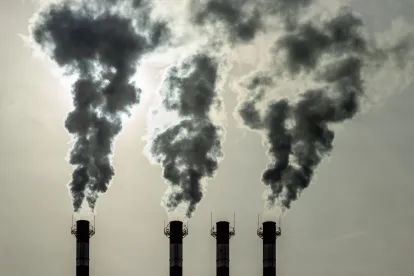In a 2-1 decision, the California Court of Appeal affirmed a California Environmental Quality Act (CEQA) Environmental Impact Report (EIR) that an oil and gas company (Company) prepared for proposed modifications to a Los Angeles refinery and its air permit. In resolving four challenges against the EIR in favor of the agency, the Court of Appeal in Communities for a Better Environment v. South Coast Air Quality Management District, --- Cal. App. 5th ---, 2020 WL 1684223 (2020), reaffirmed several foundational CEQA principles:
-
The appropriate CEQA baseline (the environmental conditions against which a project’s environmental impacts are analyzed) is left to the discretion of the agency leading the environmental review, so long as it is supported by substantial evidence;
-
For a challenge to an environmental document to be brought in court, that exact issue must have been raised at the administrative level; and
-
The environmental review document need not consider matters that have no bearing on the environmental consequences of a project.
The Challenges to the EIR
The project at issue was a proposed modification to better integrate Company’s refineries in Carson and Wilmington. Included in this modification was an increase to the thermal operating limit of a petroleum heater in the refinery’s federal air permit. The increase in the thermal operating limit would not result in any physical changes to the heater and the agency would impose emissions limits tied to the previous limit to ward off any potential increase in emissions as a result. Combined with the shuttering of certain units at the site, the EIR determined that the project would actually have a net benefit on the environment by decreasing emissions. Plaintiff/Appellant disagreed, and argued that the EIR violated CEQA for multiple reasons. We cover those challenges in the context of the broader CEQA principles addressed by the Court.
1. The CEQA Baseline is in the Discretion of the Agency
The baseline, for CEQA purposes, is generally the existing environmental conditions at the time the agency leading the environmental review announces that it is doing so through a document called a Notice of Preparation. An EIR analyzes the environmental impacts of a project against the baseline to determine whether such impacts are significant and thus must be mitigated, as well as to inform the public and decision-makers about the environmental consequences of a project. Thus, CEQA allows for a different baseline to be used when, for instance, using the environmental conditions at the time of Notice of Preparation publication may be misleading (e.g., if processes are limited by outside factors, such as a downturn in the economy, just before the NOP is published) so long as the baseline is based on substantial evidence. There are times when using the “worst-case scenario” rather than an average would be more beneficial for example.
The EIR in this case used a federal EPA methodology known as the “98th percentile” to develop the baseline. Rather than the existing conditions at the time of Notice of Preparation publication, the agency used the days falling into the “98th percentile” of the actual worst days for air pollution from the refinery over the preceding two years. In line with EPA methodologies, this practice eliminates the top 2% of worst-case days as outliers, and left the lead agency with a batch of 15 days of air pollution against which to evaluate the proposed project. The challengers argued that this was wrong, and that the agency should instead have used an average of the operating days over the previous two year period.
The Court sided with the agency. In analyzing the pertinent case law on baseline determinations (including the lodestar baseline case by the same name as this one, decided by the California Supreme Court in 2010), the Court provided a very useful “statement of law” for baseline determinations:
The agency must select a baseline based on actual conditions rather than hypothetical possibilities. There is, however, no single fixed method for measuring actual conditions. Measuring peak impacts can be appropriate under the right circumstances. The agency enjoys discretion to decide how best to measure actual conditions. Courts will review that choice for support from substantial evidence. An environmental impact report cannot, without explanation, present inconsistent and contradictory information on an important issue, or else it will fail on review.
The Court continued by concluding that determining the proper baseline is generally a “policy question.” Agencies should identify a baseline that is relevant to understanding the specific impact the agency seeks to measure. In the realm of air pollution, the worst days of air pollution are those that are of vital concern; it is those days that present the greatest risk to the public health (impacting asthmatics, for example) and it is those days (among other things) that the South Coast Air Quality Management District is tasked with decreasing. Using the EPA’s “98th percentile” methodology of focusing upon the worst days of pollution rather than an average is sensible when assessing whether the project would worsen the public health impacts of air pollution. As the Court noted, sometimes it is more important to know the “peak” or “maximum” values rather than the average value. As an example of this premise, the Court stated that “[h]ikers hoping to wade across a river want to know its maximum depth is 10 feet. They are less interested to know its average depth is two feet.” The Court rejected the challenger’s proposed “average” only baseline arguments.
Note, however, the District’s policy to rely on EPA’s “98th percentile” methodology still must meet the “substantial evidence” threshold. The Court determined that substantial evidence supported the agency’s policy decision because the same methodology was used by the federal EPA and had scientific foundation. The choice in baseline should be aimed at providing the best possible information at informing the public and decision-makers about the relevant impacts of a project; here, the worst days of air pollution.
2. Issues Raised in Court Must Exactly Mirror Issues Raised Before the Agency
CEQA requires potential litigants to exhaust administrative remedies before initiating litigation. This requires potential litigants to raise any alleged defect with the CEQA analysis to the agency “during the public comment period provided by this division or before the close of the public hearing on the project” (Pub. Res. Code § 21177(a)), which provides the agency a chance to remedy the alleged violation. Failure to do so results in a forfeiture of arguing the alleged problem to the court later.
The EIR concluded that the proposed project may increase throughput at the refinery by 6,000 barrels per day (a 2% increase). The challenger argued that the agency nowhere showed how this 6,000 barrels per day number was calculated. But as the Court noted, the appellant nowhere raised this “exact issue” with the agency; nor did any other commenter. The comments at the administrative level merely touch upon the 6,000 barrels per day number in the context of other issues, or requested information to assess “throughput claims.” The Court reasoned that such comments and requests failed to raise the required “exact issue”; the challenger “never asked the agency to reveal its calculation of the 6,000-barrels figure. The issue is forfeited on appeal.”
3. CEQA Documents Need Not Address Irrelevant Information
The challengers brought various arguments that the EIR was insufficient because it did not: (1) disclose the makeup of the crude oil coming to the refinery before the project; and (2) how much crude oil is processed by the refinery or how much it potentially could process. The Court concluded that none of this information needed to be included because the project would not make any changes that would impact the type of crude coming to the facility or how much crude the facility does or could process. And all of this information was deemed irrelevant by one important factual principle particular to refineries – refineries refine crude in a series of stages, a change to one stage does not increase the ability of the other stages to perform. Therefore, by changing the thermal limit of the heater, the refinery would not be able to process a substantially different type of crude, as the refinery would be limited by the abilities of other necessary units; the same goes for the amount that is or could be processed. There was no relevant change impacting these considerations, and therefore they did not need to be considered.
Takeaways
Three key takeaways from this recent decision emerge:
-
A baseline determination is subject to agency discretion and the Court will give deference to that decision if based upon substantial evidence, and that baseline should be aimed at providing the most pertinent analysis in the CEQA document to inform the public and decision-makers;
-
A challenge to an EIR must have been specifically raised during the administrative process to be considered by a court; and
-
Potential litigants should be comprehensive when submitting comments because failure to raise a specific issue is fatal to a later CEQA court challenge. If litigation is initiated, litigants must ensure that any challenges to environmental documents are based on issues actually raised in the comment period or at the hearing. And finally, don’t spend needless resources considering information that has no impacts relevant to the project; CEQA does not require it.





 />i
/>i

